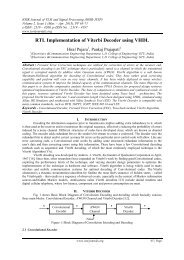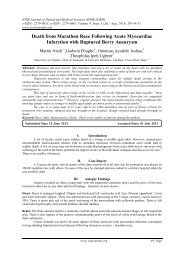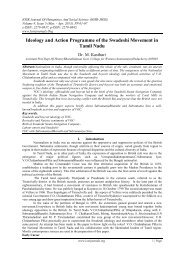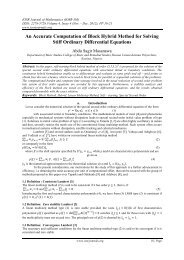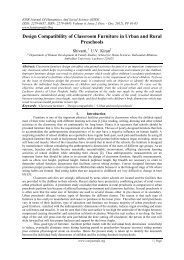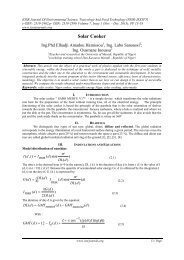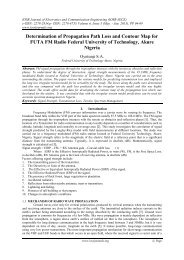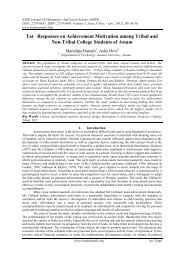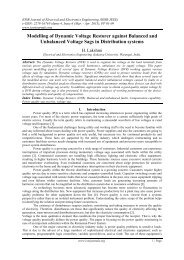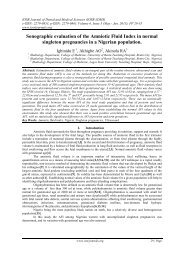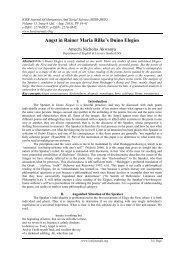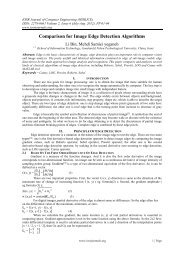Initial Conquest of India by Turks and Their Slaves - IOSR
Initial Conquest of India by Turks and Their Slaves - IOSR
Initial Conquest of India by Turks and Their Slaves - IOSR
You also want an ePaper? Increase the reach of your titles
YUMPU automatically turns print PDFs into web optimized ePapers that Google loves.
<strong>IOSR</strong> Journal Of Humanities And Social Science (JHSS)<br />
ISSN: 2279-0837, ISBN: 2279-0845. Volume 5, Issue 4 (Nov. - Dec. 2012), PP 40-45<br />
Www.Iosrjournals.Org<br />
Women <strong>and</strong> Development in <strong>India</strong>: An issue <strong>of</strong> marginalization <strong>of</strong><br />
female labour<br />
Dr. Sriparna Guha<br />
Department <strong>of</strong> Business Administration, Narula Institute <strong>of</strong> Technology<br />
Abstract: In most <strong>of</strong> the countries, including <strong>India</strong> status <strong>of</strong> women is inferior to men. Women’s opportunities<br />
are said to be restricted <strong>by</strong> ideas among employers that only certain low level limited jobs can be performed <strong>by</strong><br />
women. Women are thus said to be crowded into certain segments <strong>of</strong> the employment markets where wages <strong>and</strong><br />
conditions are lower than their male counterparts. This situation aggravated due to the pressure <strong>of</strong><br />
globalization. This phenomenon can be called marginalization <strong>of</strong> female labour”. Although rapid economic<br />
development has exp<strong>and</strong>ed women's job opportunities, most women are concentrated in lower-status jobs <strong>and</strong><br />
the informal sector. <strong>India</strong>n women, in spite <strong>of</strong> enjoying better status <strong>and</strong> position compared to other developing<br />
countries, have low levels <strong>of</strong> participation in economic activity. In such setting, this study aims to take a fresh<br />
look at the current situation <strong>of</strong> gender equality in the labour market in <strong>India</strong> <strong>and</strong> examine the trend <strong>of</strong> women’s<br />
employment status using both macro <strong>and</strong> micro level data <strong>and</strong> finally evaluates the effects <strong>of</strong> employment on<br />
economic independence relative to men. In the micro-level analysis the study examines the factors that led to<br />
the marginalization <strong>of</strong> women's labor force. The results suggest that women's work patterns in terms <strong>of</strong> formal<br />
vs. informal employment are determined <strong>by</strong> the family organization rather than <strong>by</strong> labor market .<br />
Key words: employment, empowerment, gender, globalization, marginalization<br />
I. Introduction<br />
Throughout the world participation <strong>of</strong> women in labourforce are increasing. Though women have<br />
increased their participation in technology but that participation is still below their counterparts. Pr<strong>of</strong>essional<br />
work is one <strong>of</strong> societies‟ most contested areas <strong>of</strong> equality. The rise <strong>of</strong> pr<strong>of</strong>essional projects is closely linked to<br />
power <strong>and</strong> occupational control which parallel gender, class <strong>and</strong> race clevages (Parry <strong>and</strong> Parry,1976). Now –adays<br />
most important question is no longer whether women participate in labourforce but most important<br />
questions are what types <strong>of</strong> careers women choose <strong>and</strong> what factors influence their choice in the light <strong>of</strong><br />
evidence that women are found in what could be describe (d) as “ feminine” occupations . Different research<br />
works have tried to identify the beliefs <strong>and</strong> perceptual biases that can lead to faulty conclusions about an<br />
individual <strong>and</strong> social action. From the study <strong>of</strong> Stangor,(1988) it has been found that gender stereotypes lie at<br />
the heart <strong>of</strong> many <strong>of</strong> our perceptions <strong>of</strong> the workplace <strong>and</strong> the people that operate within it. The constellation <strong>of</strong><br />
traits <strong>and</strong> attributes that are thought to uniquely describe men <strong>and</strong> women are called descriptive stereotypes.<br />
These stereotypes are applied to individuals that one encounters in work settings <strong>and</strong> become the basis for<br />
inferring their internal, stable characteristics. Thus even in situations in which person A may have very little<br />
knowledge about person B, he or she will infer a set <strong>of</strong> characteristics about A from the general category <strong>of</strong> man<br />
or woman to which person B belongs .In contrast to descriptive stereotypes, prescriptive stereotypes refer to the<br />
set <strong>of</strong> attributes <strong>and</strong> characteristics that (concentrates on the issue <strong>of</strong>) how men <strong>and</strong> women should be. This<br />
paper attempts to analyse the current situation <strong>of</strong> gender equality in the <strong>India</strong>n labour market <strong>and</strong> examine the<br />
trend <strong>of</strong> women‟s employment status. The structure <strong>of</strong> the paper is as follows: besides the introduction, section<br />
II will give the review <strong>of</strong> related literature, Section –III deals with secondary data <strong>and</strong> analyses the status <strong>of</strong><br />
women <strong>and</strong> their threats <strong>and</strong> opportunities in the current economy, finally Section-IV gives conclusion from the<br />
data analysis <strong>and</strong> suggestion.<br />
II. Review Of Literature<br />
In a study <strong>of</strong> Gladmin & Thompson (1995) a significant increase in the quality <strong>of</strong> women life related<br />
with their income rise (has been found) in case <strong>of</strong> developing countries. It is echoed with Amartya Sen‟s<br />
freedom perspective that economic unfreedom can breed social unfreedom.<br />
According to St<strong>and</strong>ing (1996) in the process <strong>of</strong> globalization with an expansion <strong>of</strong> the export oriented<br />
sector has introduces grater flexibility to the benefit <strong>of</strong> women workers in terms <strong>of</strong> absorption <strong>of</strong> women into<br />
paid work <strong>and</strong> also shift in the gender differentiated structure <strong>of</strong> occupations. But these views have been<br />
contradicted <strong>by</strong> other scholars who argue that in spite <strong>of</strong> increase in women employment the labour market<br />
remain highly segregated.<br />
According to Stiglitz (2002), it is believed that globalization is not increasing the well being for those most in<br />
need <strong>of</strong> promised economic benefit.<br />
www.iosrjournals.org<br />
40 | Page



